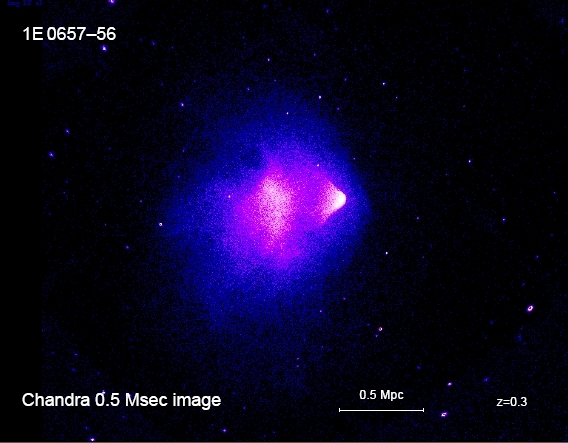Fun Science / Interesting Papers
THE BULLET CLUSTER (2006)
A Direct Empirical Proof of the Existence of Dark Matter
Clowe, D., et al.
Astrophysical Journal 648, pp.L109-L113 (2006)
This is probably the most visual evidence of dark matter to date. The red regions in this photo correspond to the “normal” baryonic mass of the two galaxy clusters, as one runs through the other (hence the bullet shape). The blue regions show the total mass of the clusters, as derived from gravitational lensing measurements.

While the baryonic mass is slowed down, the total mass (which mostly consists of dark matter) has not. This is a first-class proof that most of the mass in galaxies resides in the form of dark matter, which does not interact strongly in the same way that baryonic matter does. That’s why the dark matter regions are not slowed down, but the baryonic matter regions have.
This result put to rest the possibility that the law of gravity might by modified over long distances, since it can be explained directly through the assumption of dark matter.
PERFECT LENS (2000)
Negative Refraction Makes a Perfect Lens
Pendry, J. B.
Physical Review Letters 85, pp.3966 (2000)
This is the landmark paper that initiated the field of metamaterials. Before that, it was well known that any lens (or imaging system in general) could only manipulate the components of light larger than the wavelength of radiation. Anything smaller was lost forever, because such waves decay exponentially.

However, in this paper, it was shown that a slab of a material with refractive index -1 (as opposed to air which has +1) could not only focus light (this was known from the 1960s), but also amplify those evanescent waves and thus manipulate and focus perfectly all the information contained in the original waves.
Despite practical limitations in constructing such a material, the sole idea of perfectly controlling light is staggering.
DARK ENERGY (1998)
Observational Evidence from Supernovae for an Accelerating Universe and a Cosmological Constant
Riess, A., et al.
Astronomical Journal 116, pp.1009-1038 (1998)
and
Measurements of Omega and Lambda from 42 High-Redshift Supernovae
Perlmutter, S., et al.
Astrophysical Journal 517, pp.565-586 (1999)
That was one of the biggest shocks in our history. Right when people were debating whether the expansion of the universe would be stabilized or maybe in will become a contraction, these guys provided exprimental data that the expansion is actually… accelerating! Not only is space added between objects in the universe, but the space is added at an ever-increasing rate due to a force that was called “Dark Energy”.
This opened up a new era for cosmology since there is currently no verified theory on why this is exactly happening. It is one of the least understood aspects of cosmology at the moment.
DISCOVERY OF DNA (1953)
A structure for Deoxyribose Nucleic Acid
Watson, James D. and Francis H.C. Crick
Nature 171, pp.737–738 (1953)
This monumental paper is only a single page long, and yet it defined the field of biology for the years to come. For the first time, it suggested the correct possible structure of the DNA molecule. From the text:
We wish to suggest a structure for the salt of deoxyribose nucleic acis (D.N.A.). This structure has novel features which are of considerable biological interest.
The story of the discovery of DNA has been described in Watson’s book, The Double Helix. They basically went againsts all odds to the titan of their time, Linus Pauling, in addition to being at the right place at the right time. It is one of the best examples that you don’t have to be a genius to win the Nobel Prize :-)

FOUNDATIONS OF INFORMATION THEORY (1948)
A Mathematical Theory of Communication
Shannon, C.E.
Bell System Technical Journal, vol. 27, pp. 379-423, 623-656 (1948)
This is the landmark work of Shannon where he essentially invented the field of information theory, by describing what information is, how we can measure it, and how it can be transmitted. The term “bit” as the unit element for quanntifying information was first introduced in this paper. Shannon also laid the theoretical framework in which we describe the flow of information today: a source, a transmitter, a channel, a receiver, and finally the destination.
THE αβγ PAPER (1948)
The Origin of Chemical Elements
Alpher, R. A., H. Bethe and G. Gamow
Physical Review, 73, Issue 7, pp.803-804 (1948)
This paper argued for the first time about Big Bang nucleosynthesis. It was Alpher’s Ph.D. dissertation (Gamow was his advisor) and explained how the chemical elements in the universe were created in the first moments during the Big Bang. It was the first time that a mathematical explanation for the creation of the universe was presented.
Gamow purposely put Bethe’s name in the list without him knowing, so that their names Alpher, Bethe, Gamow sounded like the letters alpha, beta, gamma (α, β, γ), the first 3 letters of the greek alphabet. It was a fun sound game around the creation of the first elements in the universe.
Alpher’s thesis presentation was attended by over 200 people. The following day, the Washigton Post had a headline “Universe created in 15 minutes”.
THE EXPANDING UNIVERSE (1929)
A Relation Between Distance and Radial Velocity Among Extra-Galactic Nebulae
Hubble, E.
Proceedings of the National Academy of Sciences,15 (3), pp.168–173 (1948)
This was the first time that we realized that the universe we live in is not static, as Einstein wanted it to be. Instead, Hubble found that the further away a galaxy was from us, the faster it moves away from us. And this happens because new space is created and inserted everywhere in the universe, providing the first observational evidence for the Big Bang Theory that had been proposed a couple of years ago.
Hubble did this by measuring the galaxy speeds through redshifts (the frequency spectrum shifts to more red frequencies with increasing speed), and their distances based on the brightness (the brightness of certain objects is calibrated and known as a function of distance). When plotted against each other, the result was the straight line you see on the graph on the right. Since then the error margin on that bar has become much less.

E=MC^2 (1905)
Ist die Tragheit eines Korpers von seinem Energiegehalt abhangig?
(Does the Inertia of a Body Depend Upon Its Energy Content?)
Einstein, A.
Annalen der Physik, 18:639-641, (1905)
This paper presented what is arguably the most famous equation in the history of science. Einstein predicted that each mass has an energy equivalent, an energy that is independent from its kinetic or potential energy: it is simply energy that any object has as long as it has mass. In his own words:
If a body gives off the energy L in the form of radiation, its mass diminishes by L/c². The fact that the energy withdrawn from the body becomes energy of radiation evidently makes no difference, so that we are led to the more general conclusion that
The mass of a body is a measure of its energy-content;
if the energy changes by L, the mass changes in the same sense by L/9 × 1020, the energy being measured in ergs, and the mass in grammes. […] If the theory corresponds to the facts, radiation conveys inertia between the emitting and absorbing bodies.
This is one of Einstein’s Annus Mirabilis papers, where he also published 3 more papers regarding Special Relativity, Brownian Motion and the Photoelectric Effect.
